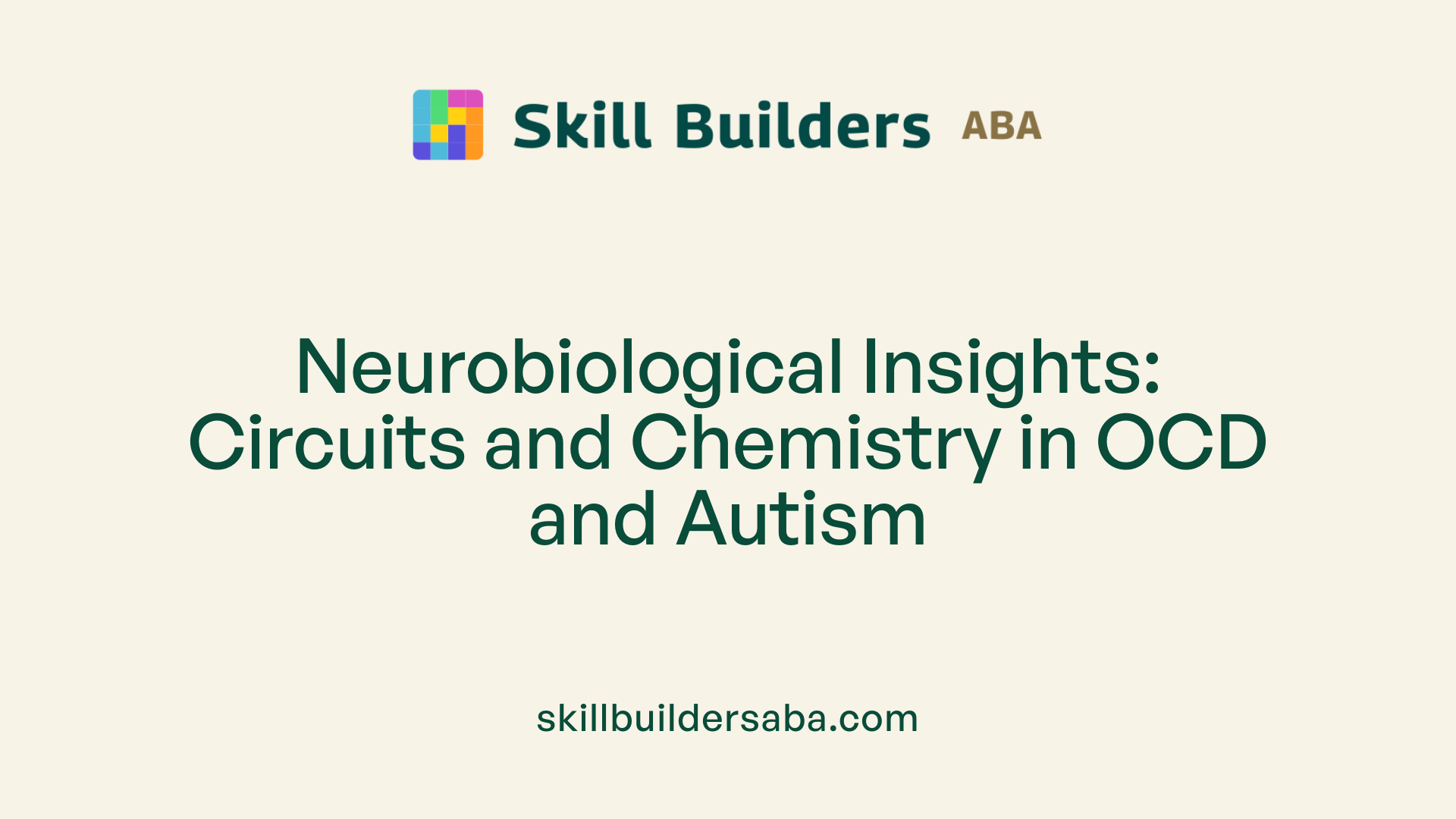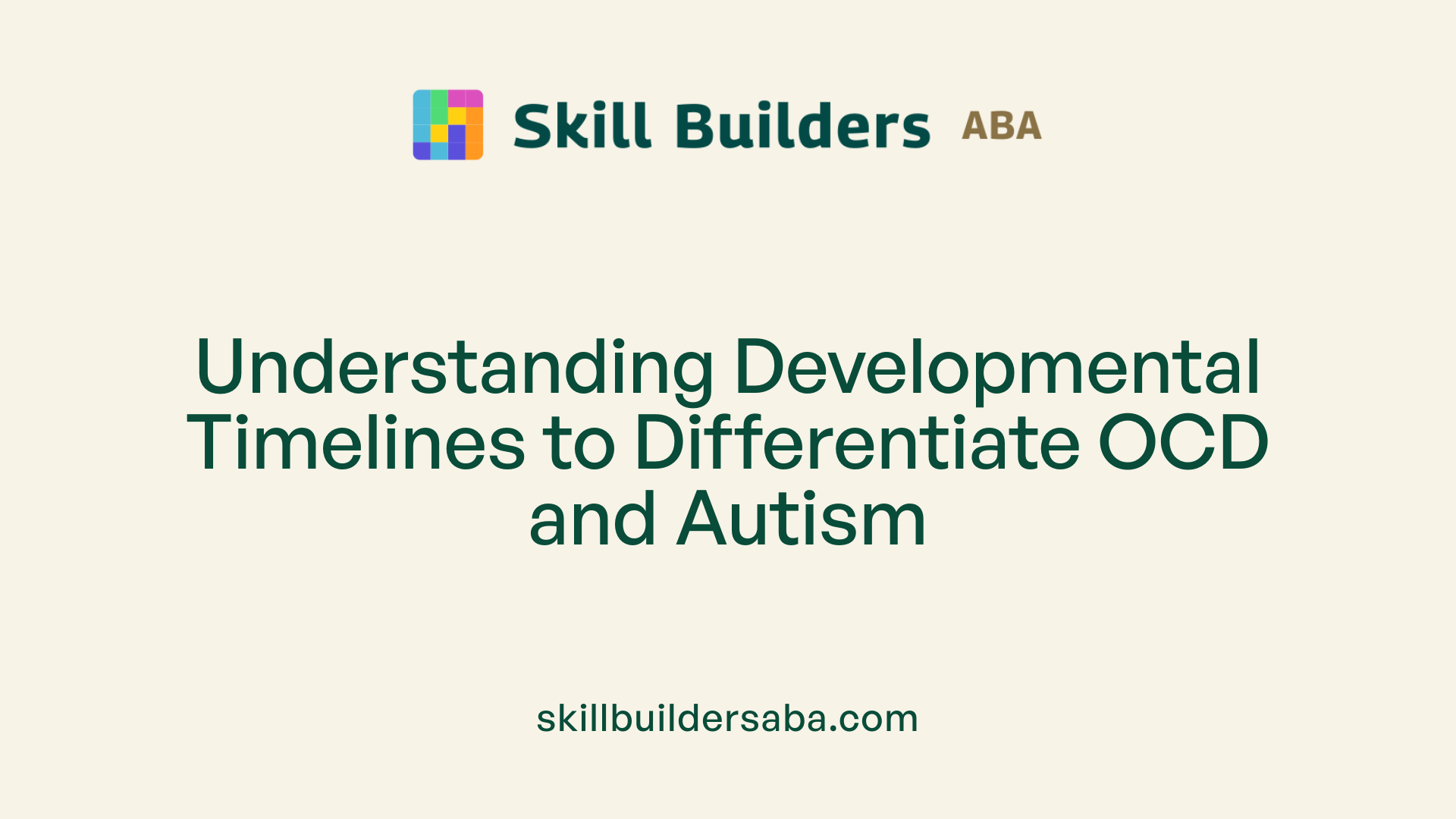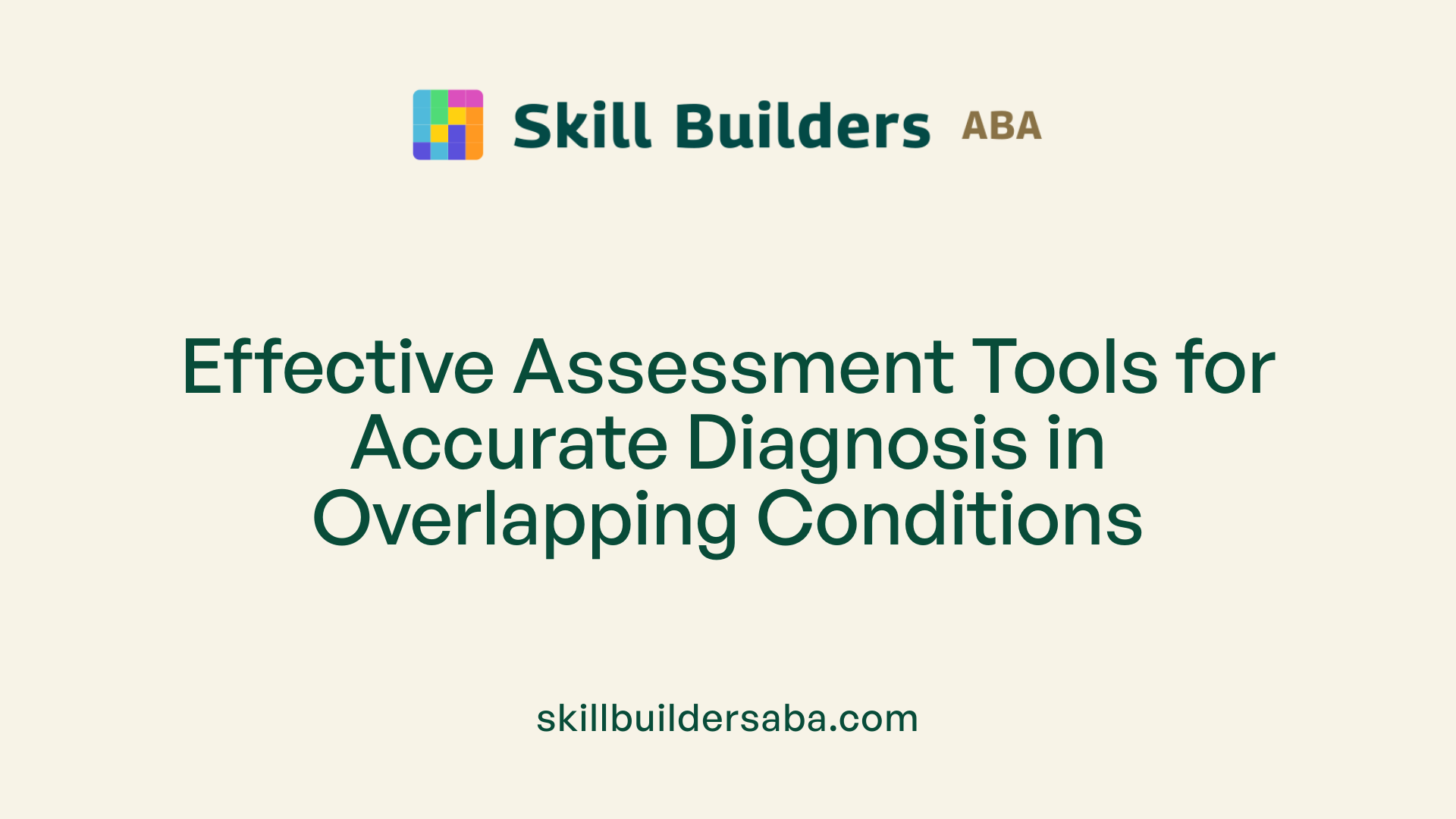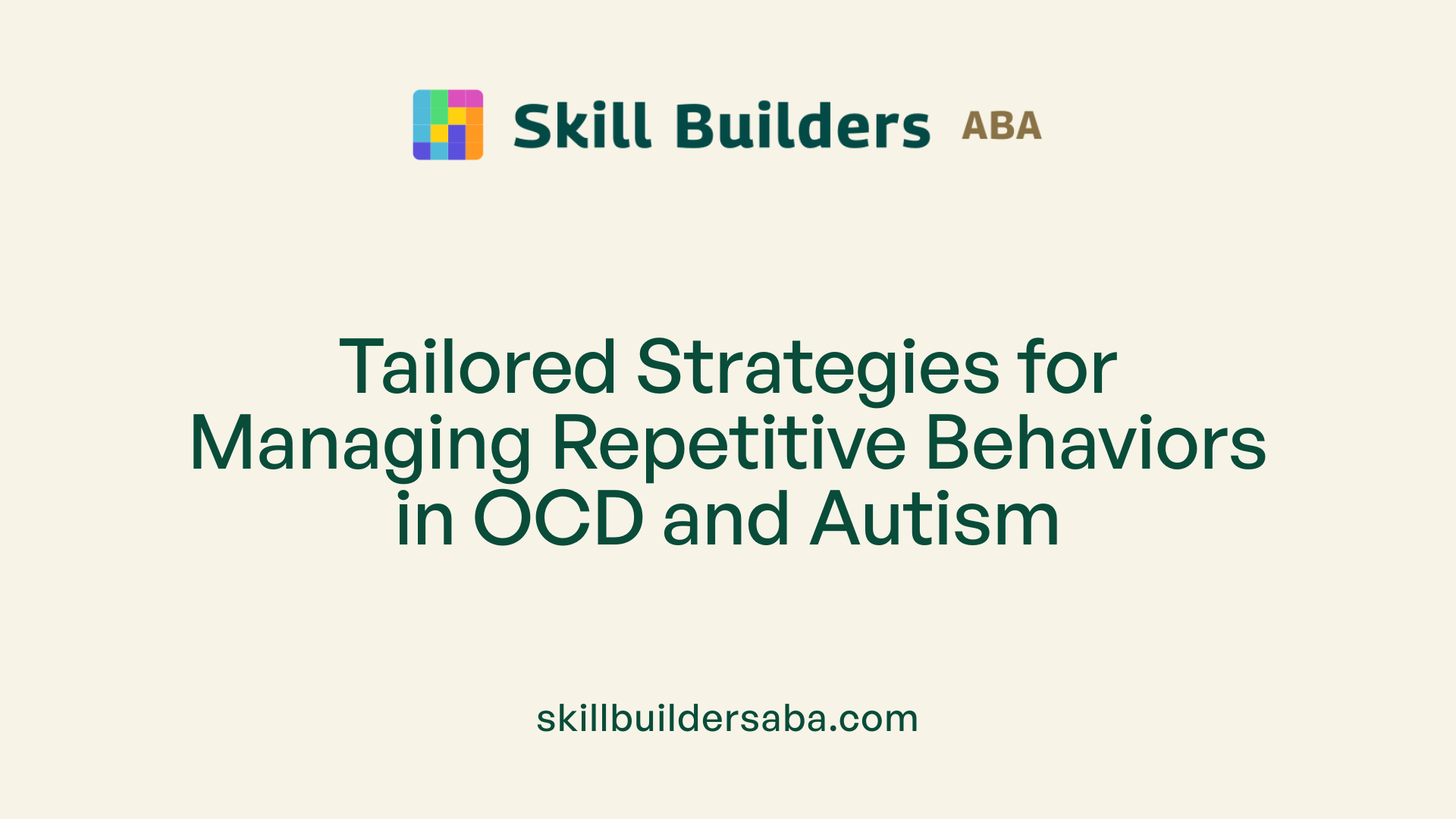OCD vs. Autism
Deciphering the Complex Relationship Between OCD and Autism Spectrum Disorder

Understanding Overlapping Behaviors and Distinct Differences
OCD and Autism Spectrum Disorder (ASD) are distinct conditions with unique features, yet they often overlap in symptoms like repetitive behaviors. This comprehensive overview aims to clarify their differences, similarities, diagnostic challenges, and how understanding these nuances can improve recognition and treatment.
Defining OCD and Autism Spectrum Disorder

What are the main differences and similarities between OCD and Autism Spectrum Disorder?
Both Obsessive-Compulsive Disorder (OCD) and Autism Spectrum Disorder (ASD) feature repetitive behaviors and challenges with change. However, their motivations, emotional experiences, and underlying causes set them apart.
In OCD, repetitive behaviors—such as excessive cleaning, checking, or rituals—are driven by intrusive thoughts that cause significant anxiety or distress. These compulsions are performed to reduce or neutralize these distressing obsessions, which often include fears of contamination, harm, or a need for symmetry. The behaviors are ego-dystonic, meaning individuals usually find them unwanted and recognize them as irrational, though they feel compelled to perform them to alleviate anxiety.
Conversely, in autism, repetitive behaviors known as restricted and repetitive behaviors (RRBs), like lining up objects, rocking, or engaging in focused interests, typically serve self-soothing, sensory regulation, or are driven by curiosity and joy. These behaviors are usually pleasurable or neutral, not distressing. For example, autism-related stimming behaviors can help manage sensory overload or provide comfort.
Despite these differences, both conditions share some neural circuit involvement, particularly in the basal ganglia, which is linked to routine and stereotyped behaviors. Furthermore, behaviors such as ritualistic activities or strict routines appear in both, though their functional purpose diverges.
Another significant difference involves the emotional response associated with the behaviors. OCD behaviors are motivated by an attempt to reduce or prevent distress caused by intrusive thoughts, often leading to feelings of anxiety, guilt, or shame. Autism behaviors, however, tend to be intrinsic or pleasurable, aligned with personal interests or sensory preferences.
Shared symptoms can make diagnosis challenging. Both conditions may include social difficulties, sensory sensitivities, and resistance to change. However, in autism, these features are inherent parts of the developmental profile, usually evident from early childhood, whereas OCD typically develops later and centers on specific obsessions and compulsions.
In summary, while there are overlaps in behaviors such as repetition and routines, their functions, emotional contexts, and origins are distinct. Recognizing these differences is essential for accurate diagnosis and tailored treatment approaches.
Shared and Distinct Neurobiological Underpinnings

What are common symptoms and overlaps between OCD and autism?
Common symptoms and overlaps between OCD and autism include repetitive behaviors and ritualistic actions; however, their functions differ, with OCD behaviors driven by anxiety and distress, and autistic behaviors serving self-soothing or predictable routines. Both conditions feature sensory sensitivities and may involve intrusive thoughts, but OCD obsessions are often unwanted, distressing, and ego-dystonic, whereas autistic obsessions tend to be focused interests or passions.
Distinguishing between the two involves evaluating the onset, context, and purpose of behaviors—autistic behaviors typically occur early and are pleasurable or neutral, while OCD symptoms usually emerge later and are associated with anxiety.
Prevalence and Co-occurrence Studies show that there is a high rate of overlap, especially among adolescents and adults. For example, one meta-analysis indicates that about 17% of individuals with autism also have OCD. Conversely, individuals with OCD are substantially more likely to be diagnosed with autism later in life. This overlap presents diagnostic challenges but underscores the importance of comprehensive assessments.
Impact on Treatment Understanding these overlaps is crucial for developing appropriate treatment plans. Misdiagnosis can lead to ineffective interventions if the behaviors are not correctly interpreted, emphasizing the need for nuanced evaluation.
What brain circuits are involved in OCD and autism?
Both OCD and autism involve similar brain circuitry, particularly around the caudate nucleus within the basal ganglia. This area is implicated in the regulation of routines and stereotyped behaviors. In individuals with both conditions, this region may show abnormal activity, contributing to their repetitive behaviors.
Caudate Network The caudate is part of a larger circuit that includes the frontal cortex and other parts of the basal ganglia. This network is essential for goal-directed behavior, habit formation, and the suppression of unwanted actions. Disruptions in this circuitry can lead to compulsions in OCD and insistence on sameness in autism.
Shared Features in Neural Function Neuroimaging studies suggest that both conditions exhibit altered activity within these circuits, although the specific functional consequences differ based on the context. In OCD, hyperactivity may produce compulsions, while in autism, the same circuits may contribute to self-regulatory behaviors.
What neurobiological factors underlie these conditions?
The underlying neurobiological factors include genetic predispositions, neurodevelopmental abnormalities, and neurotransmitter imbalances, prominently involving serotonin. Variations in genes affecting serotonergic pathways have been linked to OCD, while neurodevelopmental irregularities affecting brain maturation are more prominent in autism.
Genetic and Neurochemical Factors Research indicates that both conditions may share genetic markers related to brain development and neurotransmitter function. Serotonin dysregulation, in particular, plays a role in obsessive-compulsive symptoms. Structural differences, such as enlarged or atypically functioning basal ganglia and cortical areas, are observed in both conditions.
Environmental and Developmental Influences Environmental factors like trauma or prenatal influences can contribute to the neurobiological profile of OCD. Autism’s neurodevelopmental origins are evident from early childhood symptoms and atypical brain growth patterns.
Summary of Overlapping and Divergent Neurobiological Features
| Aspect | Autism | OCD | Shared Features |
|---|---|---|---|
| Brain Circuits | Abnormalities in caudate, cortical regions | Hyperactivity in caudate, orbitofrontal cortex | Both involve caudate and basal ganglia circuits |
| Onset | Early childhood | Usually adolescence | Both involve circuits related to routines and habits |
| Neurotransmitters | Serotonin, GABA, glutamate | Serotonin, dopamine | Neurotransmitter imbalances common to both |
| Genetic Factors | Multiple genes affecting neurodevelopment | Genes affecting serotonin pathways | Genetic overlaps suggest shared etiology |
| Structural Differences | Atypical cortical development, enlarged basal ganglia | Changes in caudate volume | Brain structural differences reflect functional impairments |
Understanding these neurobiological foundations provides insight into why behaviors can appear similar yet serve different functions across the two conditions. It also aids in the development of targeted treatments that address specific circuitry or neurotransmitter imbalances, ultimately improving outcomes for individuals with autism, OCD, or both.
Overlapping Behaviors and Their Functions
How can OCD and autism be distinguished through diagnosis?
Differentiating OCD from autism relies heavily on understanding the underlying functions, motivations, and emotional impact of behaviors associated with each condition. Both autism and OCD often feature repetitive behaviors, but the reasons behind and experiences of these behaviors differ significantly.
In OCD, repetitive actions—known as compulsions—are driven by intrusive, unwanted thoughts called obsessions. These behaviors are performed to alleviate the anxiety or distress caused by these thoughts. For instance, a person might repeatedly check if a door is locked because of a fear of harm or contamination. These compulsions are often ego-dystonic, meaning they feel alien, unwanted, and cause emotional discomfort.
In contrast, repetitive behaviors in autism, often referred to as restricted and repetitive behaviors (RRBs), serve different purposes. These behaviors are usually ego-syntonic—pleasurable or neutral—and serve functions like self-soothing, sensory regulation, or expressing interests. Autism traits such as lining up objects, flicking fingers, or engaging in focused interests are often automatic, and many autistic individuals find these activities comforting or enjoyable.
The age of onset and developmental course also aid diagnosis. Autism symptoms typically appear by age 2 and tend to be persistent, affecting various aspects of development. OCD symptoms often develop later, usually between ages 8 and 12, and might fluctuate over time.
Clinicians use various tools to identify these differences. Validated assessments like the Yale-Brown Obsessive-Compulsive Scale adapted for autism spectrum disorder (CYBOCS-ASD), Autism Diagnostic Interview-Revised (ADI-R), and behavioral analysis help determine whether behaviors are driven by compulsive anxiety or serve self-regulatory functions.
Beyond behavior content, it is essential to assess the individual’s emotional response. Behaviors that induce distress or are performed to prevent perceived negative outcomes generally indicate OCD. Conversely, behaviors that are pleasurable, self-stimulatory, or serve as an interest tend to align with autism.
Ultimately, the clinical evaluation must include careful observation, detailed history-taking, and consideration of the context in which behaviors occur. A multidisciplinary approach helps in accurately distinguishing OCD from autism, guiding effective intervention plans.
Developmental Pattern and Age of Onset

What are common symptoms and overlaps between OCD and autism?
Both obsessive-compulsive disorder (OCD) and autism spectrum disorder (ASD) feature repetitive behaviors and rituals, but these serve different functions. In autism, repetitive actions or restricted interests often act as self-soothing, help manage sensory overload, and provide predictability. These behaviors are typically pleasurable, automatic, and embedded into daily routines.
In contrast, OCD behaviors are driven by intrusive, unwanted thoughts called obsessions, which provoke significant anxiety. The compulsions performed in OCD are aimed at reducing this distress, often feeling ego-dystonic—meaning the individual recognizes them as disruptive or unwanted.
Sensory sensitivities are common in both conditions. People with autism might engage in behaviors like lining up objects or repetitive movements to self-regulate sensory input. Similarly, OCD compulsions such as repeated handwashing or checking can be linked to fears of contamination or harm.
Diffentiating between these behaviors involves understanding their origins, emotional impact, and timing. Autism behaviors usually start early, often by age 2, and are associated with pleasure or self-regulation.
OCD symptoms typically emerge later, often between the ages of 8 and 12, and are characterized by the desire to alleviate anxiety. Misdiagnosis can occur if these overlapping behaviors are not carefully assessed, emphasizing the importance of detailed clinical evaluation.
How can understanding the differences and similarities between OCD and autism aid in recognition and support?
A clear grasp of how OCD and autism overlap and differ can significantly aid in accurate diagnosis, leading to more effective and personalized interventions. Recognizing that repetitive routines in autism are ego-syntonic—that is, satisfying or meaningful to the individual—and not linked to distress can prevent confusion with OCD rituals.
Conversely, understanding that OCD behaviors are ego-dystonic—that they cause distress and are unwanted—can help clinicians differentiate between the two, especially when behaviors occur later in development.
Knowledge of symptom timing, subjective experience, and emotional context helps tailor assessment tools and therapeutic approaches. For example, special assessments designed for autistic individuals, like the Anxiety Scale for Children—ASD (ASC-ASD), improve detection accuracy.
Furthermore, an appreciation of shared biological factors, such as overlapping brain circuits involving the caudate network, guides comprehensive treatment strategies that address both conditions simultaneously.
Supporting individuals with clear, differentiated understanding fosters effective management, reduces misdiagnosis, and enhances overall quality of life by respecting their specific needs and experiences.
Impact of Comorbidity on Treatment Strategies
How can OCD and autism be distinguished through diagnosis?
Differentiating OCD from autism involves a careful assessment of behavioral patterns, emotional responses, and developmental history. In OCD, repetitive behaviors—known as compulsions—are driven by intrusive, unwanted thoughts called obsessions that cause significant distress. These actions are aimed at reducing anxiety and are often experienced as ego-dystonic, meaning they feel foreign or unwanted to the individual.
Conversely, repetitive behaviors in autism, referred to as restricted and repetitive behaviors (RRBs), are usually ego-syntonic, meaning they are experienced as part of oneself and often provide comfort or serve sensory regulation. These behaviors often emerge early in development, typically by age 2, and tend to be pleasurable or serve a self-stimulatory function.
The age of onset and the behavioral function are key distinguishing features. Autism symptoms are persistent and apparent early, whereas OCD behaviors tend to develop between ages 8 and 12, often fluctuating over time.
Clinical assessment tools play a vital role in diagnosis. Instruments like the Children’s Yale-Brown Obsessive Compulsive Scale adapted for Autism Spectrum Disorder (CYBOCS-ASD), Autism Diagnostic Interview-Revised (ADI-R), and behavioral interviews help distinguish the motivational and emotional nuances of behaviors.
A multidisciplinary approach, including input from psychologists, psychiatrists, and neurologists, increases diagnostic accuracy. Recognizing the underlying motivation—whether behaviors serve anxiety relief or self-stimulation—is essential for tailoring effective treatment plans.
This nuanced understanding ensures that interventions address the specific needs of individuals, whether that involves managing anxiety in OCD or supporting self-expression and sensory regulation in autism.
How do treatment modifications differ in cases with both OCD and autism?
Managing comorbid OCD and autism requires adaptations in standard treatment approaches. Traditional cognitive-behavioral therapy (CBT) and exposure and response prevention therapy (ERP) are first-line treatments for OCD. However, when autism co-occurs, these therapies often need adjustments to accommodate sensory sensitivities, communication preferences, and cognitive styles.
Therapists may incorporate visual supports, social stories, and gradual exposure techniques tailored to the individual’s sensory profile. Skills training in emotional regulation and social understanding can enhance therapy effectiveness.
Research indicates that CBT and ERP may have reduced efficacy in autistic individuals if not adapted appropriately. For example, rigid routines and heightened sensory sensitivities can interfere with engagement in therapy, prompting clinicians to modify session content, pacing, and expectations.
Pharmaceutical options, such as selective serotonin reuptake inhibitors (SSRIs), are used to target OCD symptoms. Nonetheless, medication response can vary, and side effects may be more common in autistic individuals. Close monitoring and dose adjustments are necessary, and medications are often combined with tailored behavioral interventions.
Family involvement and psychoeducation are crucial. Supporting families to understand the interplay of symptoms and customizing routines can reduce stress and improve outcomes.
In summary, treating co-occurring OCD and autism demands a personalized approach, integrating behavioral, pharmacological, and environmental strategies to effectively manage both conditions.
Efficacy of CBT and ERP in autism with OCD
Cognitive Behavioral Therapy (CBT) and Exposure and Response Prevention (ERP) are evidence-based treatments for OCD that have been adapted for autistic populations. When properly tailored, these therapies can significantly reduce OCD symptoms.
In autistic individuals, therapy adaptations include using visual aids, simplifying language, and involving caregivers to reinforce strategies outside sessions. The focus is on making treatments accessible, engaging, and emotionally supportive.
ERP involves gradual exposure to feared stimuli with the prevention of compulsive responses. To do this effectively in autism, therapists often incorporate special interests and sensory considerations to motivate participation.
Studies show that while the core principles of CBT and ERP remain effective, their success hinges on customization. Outcomes are generally improved when clinicians assess each person's unique sensory sensitivities, communication style, and cognitive level.
Challenges include difficulty in motivation, comprehension, and tolerating exposure tasks. Therefore, ongoing assessment and flexible pacing are essential.
With these modifications, CBT and ERP have demonstrated promising results, including reductions in compulsive behaviors and improvements in quality of life for autistic individuals with OCD.
Pharmaceutical considerations
Medications, particularly SSRIs like fluoxetine, sertraline, and fluvoxamine, are commonly prescribed for OCD. They help reduce obsessive thoughts and compulsive behaviors.
However, in autistic populations, the effectiveness of SSRIs can be variable. Side effects such as agitation, sleep disturbances, and digestive issues may be more pronounced, requiring careful monitoring.
Additionally, medications should be used as part of an integrated treatment plan. Behavioral interventions should be prioritized, with pharmacotherapy serving as an adjunct when symptoms significantly interfere with daily functioning.
Clinicians must also consider comorbidities such as anxiety and ADHD, which are prevalent in both OCD and autism, influencing medication choices and dosing. Regular assessments of side effects and therapeutic efficacy are crucial.
In summary, pharmacological treatment in autism with OCD requires careful individualization, ongoing evaluation, and family education to optimize benefits and minimize risks.
Specialized Assessment Tools and Techniques

Tools for Assessing OCD in Autistic Populations
Assessing OCD within autistic individuals requires specialized tools that acknowledge the unique presentation of symptoms in this group. Standard measures like the Yale-Brown Obsessive-Compulsive Scale (Y-BOCS) are commonly used but were originally developed for the general population and may not capture the full scope of symptoms in autistic individuals.
To address this, clinicians increasingly utilize tools such as the Anxiety Scale for Children—Autism Spectrum Disorder (ASC-ASD) and the Children’s Yale-Brown Obsessive-Compulsive Scale Modified for Autism Spectrum Disorder (CY-BOCS-M). These instruments consider sensory sensitivities, communication differences, and the ego-syntonic nature of some autistic behaviors that can resemble OCD compulsions.
Challenges in Diagnosis
Diagnosing OCD in autistic populations presents several challenges.
- Symptom Overlap: Both conditions exhibit repetitive behaviors, routines, and resistance to change, making it difficult to differentiate between ASD-related behaviors and OCD compulsions.
- Communication Difficulties: Autism-related communication deficits can hinder the accurate reporting of obsessions or compulsions, especially when behaviors are covert or internal.
- Ego-Syntonic vs. Ego-Dystonic: Autism behaviors are often perceived as acceptable or pleasurable (ego-syntonic), whereas OCD behaviors are distressing and intrusive (ego-dystonic). Recognizing this distinction requires nuanced assessment.
- Limited Awareness and Training: Many clinicians lack specialized training in differentiating overlapping symptoms, which can lead to misdiagnosis or underdiagnosis of OCD in autistic individuals.
Importance of Clinician Training
Effective assessment hinges on proper training. Clinicians should be familiar with the phenomenological differences and the presentation of OCD in autistic populations.
Training should include:
- Understanding how OCD symptoms manifest differently in autism.
- Utilizing validated assessment tools designed for autistic individuals.
- Developing skills to assess the emotional impact and function of repetitive behaviors.
- Recognizing the importance of sensory profiles, as sensory sensitivities can influence both autism and OCD symptoms.
- Incorporating structured interviews and collateral information from family or caregivers.
By improving clinicians' expertise, we can ensure more accurate diagnosis, leading to tailored interventions that effectively address both conditions.
How can understanding the differences and similarities between OCD and autism aid in recognition and support?
Understanding the nuances between OCD and autism enhances recognition, leading to more accurate diagnosis and effective support. Knowing that autism-related repetitive behaviors are often ego-syntonic and serve self-regulation or pleasurable functions contrasts with OCD behaviors, which are ego-dystonic, driven by anxiety, and often experienced as intrusive. Recognizing the timing of symptom onset—autism symptoms typically appear early in development, whereas OCD can develop later—further aids differentiation.
This awareness facilitates tailored interventions, such as adapting cognitive-behavioral therapies for individuals with both conditions, and supports empathetic understanding of their lived experiences. When clinicians differentiate these conditions accurately, individuals receive more precise support, reducing distress and improving quality of life. Ultimately, understanding these distinctions empowers support systems to be more responsive, respectful, and effective in managing these complex, overlapping conditions.
Practical Strategies and Support for Individuals

How can understanding the differences and similarities between OCD and autism aid in recognition and support?
Recognizing the nuanced differences and overlaps between obsessive-compulsive disorder (OCD) and autism spectrum disorder (ASD) is vital for appropriate support and intervention. Since both conditions feature repetitive behaviors, understanding their distinct purposes helps clinicians and caregivers respond effectively.
In autism, repetitive behaviors or restricted interests are often intrinsic to the individual's identity and serve self-stimulation, sensory regulation, or enjoyment. These behaviors tend to be ego-syntonic, meaning they are aligned with the person's sense of self and are often pleasurable or neutral.
Conversely, OCD behaviors are ego-dystonic, driven by intrusive thoughts and anxiety, and performed to reduce distress. Recognizing this emotional component helps differentiate between the two and avoid mislabeling supportive behaviors.
Awareness of when behaviors develop—autistic behaviors typically emerge early in childhood, while OCD often develops later—can enhance early detection. Additionally, understanding that behaviors with similar outward appearances—like routines or rituals—serve different functions guides targeted intervention.
This knowledge extends to shared neurobiological pathways, such as circuits involving the caudate nucleus, which influence routines and stereotyped behaviors. Recognizing the biological underpinnings supports adopting comprehensive treatment strategies that address both conditions.
Overall, this understanding promotes tailored support strategies that respect individual experiences, improve diagnostic accuracy, and result in more effective management, thus enhancing quality of life for those affected.
Significance of Early Intervention and Parent Education
How can understanding the differences and similarities between OCD and autism aid in recognition and support?
Gaining a clear understanding of the differences and similarities between Obsessive-Compulsive Disorder (OCD) and autism spectrum disorder (ASD) is crucial for accurate recognition and effective support.
Autism primarily manifests early in life, often before age 2, with core features such as social communication challenges, restricted interests, sensory sensitivities, and repetitive behaviors, known as Restrictive-Repetitive Behaviors (RRBs). These behaviors often serve functions like self-regulation or enjoyment, and are usually experienced as intrinsic to the individual. These repetitive actions, including hand-flapping or lining up objects, tend to be pleasurable or neutral and are often used as coping mechanisms.
In contrast, OCD typically emerges later, usually between ages 8 and 12, characterized by obsessions—intrusive, unwanted thoughts or images—and compulsions—ritualistic behaviors performed to reduce anxiety or prevent feared outcomes. These compulsions are ego-dystonic, meaning individuals find them distressing, unwanted, and intrusive, often feeling like they are coming from their own minds rather than being part of their identity.
Distinguishing between these behaviors hinges on understanding their emotional and functional context. In autism, repetitive behaviors serve to manage sensory overload or provide pleasure, and are generally not driven by anxiety. Conversely, OCD compulsions aim to relieve anxiety caused by obsessions and are performed in response to intrusive thoughts. This emotional distinction informs targeted interventions, as behaviors motivated by anxiety require different therapeutic approaches.
Shared neurological bases, such as involvement of the caudate network, suggest some common neurobiological pathways, yet the underlying motivations and emotional responses differ significantly. Recognizing these points allows clinicians to avoid misdiagnosis, which can occur due to overlapping symptoms like routines and rituals.
Having awareness of these distinctions guides the development of tailored assessments and treatments. For example, understanding that some repetitive behaviors in autism are ego-syntonic (aligned with the individual's identity) and pleasurable, while OCD behaviors are ego-dystonic and distressing, helps clinicians select appropriate therapies such as cognitive-behavioral therapy (CBT) with exposure and response prevention (ERP) for OCD, and behavioral interventions focusing on social skills for autism.
Moreover, recognizing the co-occurrence of OCD and autism—where studies suggest about 17–25% of autistic individuals also have OCD—supports the need for comprehensive evaluations. This awareness enables practitioners to implement interventions that address both conditions concurrently, improving overall outcomes.
Effective support also depends on educating families, caregivers, and educators about these differences. This knowledge empowers them to create supportive environments tailored to each individual's needs, reducing stigma and promoting better understanding.
In sum, understanding the nuanced differences and overlaps between OCD and autism enhances diagnostic accuracy, guides personalized treatment plans, and fosters supportive environments. This ultimately improves the quality of life for individuals navigating these complex conditions.
Advancing Awareness and Support
Differentiating OCD from autism requires careful assessment of behavior function, emotional context, and developmental history. Both conditions’ overlapping symptoms necessitate specialized tools and trained clinicians to ensure accurate diagnosis. Increased awareness and understanding of their distinct and shared features enable tailored interventions, ultimately improving quality of life for individuals affected. Continued research and education remain vital to refining diagnostic criteria and treatment strategies, fostering a more supportive environment for those navigating these complex conditions.
References
- OCD vs. Autism - Neurodivergent Insights
- OCD and Autism - International OCD Foundation
- OCD vs. Autism: Similarities and differences - Medical News Today
- OCD - National Autistic Society
- OCD and Autism: Similarities and Differences
- Autism and ADHD vs OCD: Understanding the Connections ...
- Autism vs OCD: Key Differences and Overlaps | Inclusive ABA
- 'Autism is the Arena and OCD is the Lion': Autistic adults ...
.svg)














